

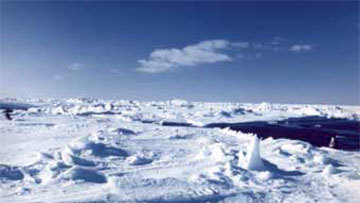


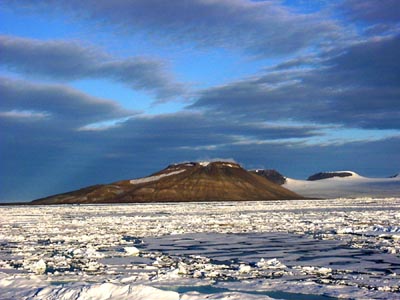

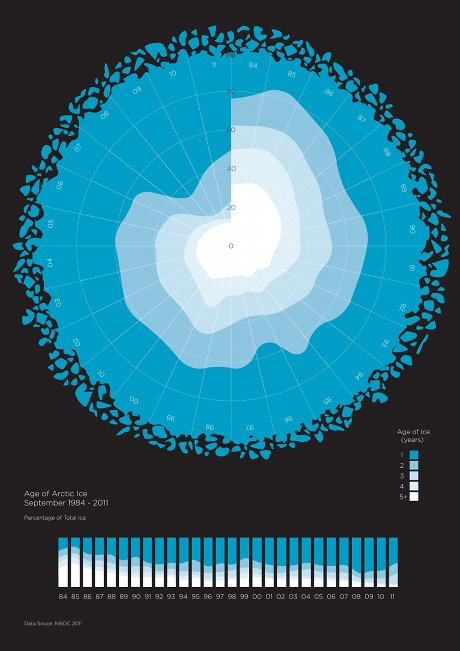 |
|---|
November 30, New Visualizations of Sea Ice Decline
New ways to depict the ongoing sea ice retreat happening at the North Pole are always appreciated. Both of these info-graphics - designed by Rupert Burton and published at the BBC Earth Life Is blog - nicely contain the Arctic Circle as thematic motif.
|
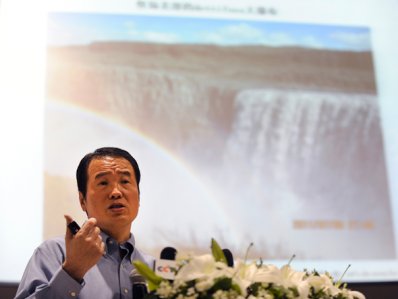 |
November 30, Iceland foils Chinese investor’s bid to buy land
Iceland’s Minister of the Interior, Ogmundur Jonasson, rejected Chinese businessman Huang Nubo’s bid to purchase a large tract of territory in the northeastern region of the country. Huang had sought an exemption from an Icelandic law which prohibits nationals from outside the European Economic Association from purchasing large amounts of land. Huang wanted to purchase and develop a 115 square mile parcel of land in Gromsstaoir o Fjollum, which would have equalled 0.3% of the country’s territory. He had planned to spend $200 million acquiring the land and turning it into an ecoresort, an investment that could have been beneficial to Iceland’s economy as it recovers from the financial crisis.
|
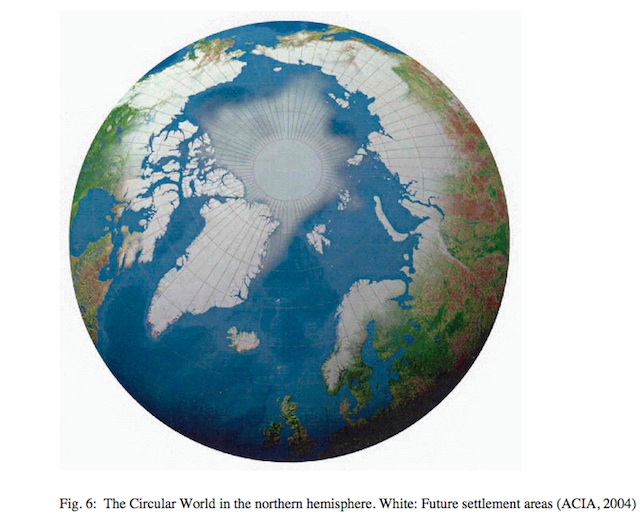 |
November 30, Arctic to be the Center of a New World by 2300
If climate change continues along the business-as-usual path, the 24th century’s new world will be in some ways more like the world of Ancient Greece – with what’s left of the world’s inhabitants trading around a single sea.
For the Ancient Greeks, it was the Mediterranean Sea. For those of our descendants that survive, it will be what is now the Arctic circle. |
November 29, Extended admission in Arctic Geology and Technology for spring 2012 semester
There are still available student places at BSc and MSc level within the technology and geology department in spring 2012. The extended admission will be on a first come, first serve basis so apply today!
|
November 29, Two new geological maps of Svalbard issued
Two new geological map sheets of the 1:100 000 series of Svalbard were issued in November 2011. Both map sheets cover mainly areas in Ny-Friesland in northeastern Spitsbergen.
|
November 28, Arctic Frontiers 2012 program updates
Attached you will find the updated policy program for the 6th Arctic Frontiers conference. Learn more about confirmed speakers for the conference policy and science sections. Arctic Frontiers evening program will include, to name a few, Reindans, bacalao fest at DRIV, PolArt Exhibition 2012, H?logaland Teater and the memorable Mentor Speed Dating. Since our last update, Arctic Frontiers has visited Arkhangelsk for the 2nd anniversary celebration of Lomonosov and Nansen. During the visit Arctic Frontiers Chair and Troms County Governor were both celebrated for their international efforts. Read more about the anniversary events in Arkhangelsk.
|
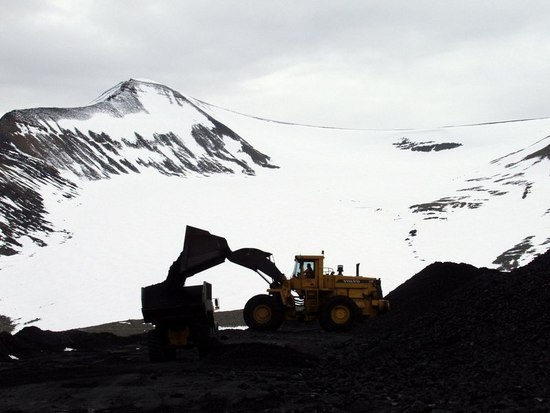 |
November 28, Decision on new Svalbard coal mine delayed
New Norwegian coal mining on Svalbard is a hot potato for the government. Ministry of Environment is likely not to take a decision before next year.
Norway’s current coal mine in Svea Nord will run out of resources within the next few years. The state own company Store Norske adopted in September 2010 a business plan for opening a new coal mine in Lunckefjell, just north of the current mine. |
November 28, News from Eastern Svalbard
The work on writing a management plan for Eastern Svalbard Nature reserves is still ongoing. Now the reports from the working groups Research/Education and Tourism are available in English.
|
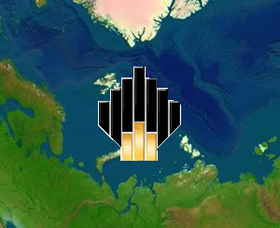 |
November 25, Russian military blocks Barents drilling
The Russian Ministry of Defence refuses to give oil company Rosneft access to fields in the Barents Sea.
A source in the Russian Mineral Extraction Agency (Rosnedra) confirms that Rosneft has got three bids for field licenses turned down because of objections from the Ministry of Defence.
|
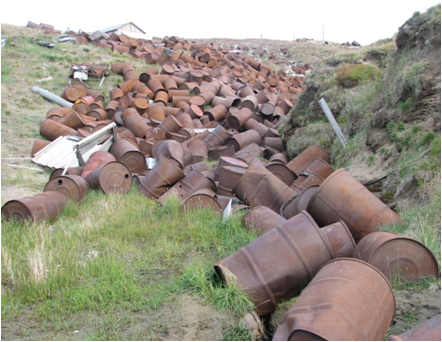 |
November 25, New Arctic Contaminants Project
Industrial development of the Arctic has been accompanied by waste accumulation, especially in the vicinity of indigenous villages. This represents a growing threat to safety and health of the Arctic people who – due to traditional living conditions – are exposed to higher levels of contamination in the air, water, soil and their food supply.
To address contaminant issues in indigenous peoples’ communities in remote areas of the Arctic, the Permanent Participants of the Arctic Council proposed the elaboration of the Indigenous Peoples Community Action Initiative. This initiative was approved by the Arctic Council at the Ministerial Meetings in Salekhard and Troms? (under ACAP). |
November 25, ESA Earth System Monitoring & Modelling Summer School
ESA Earth Observation Summer School on "Earth System Monitoring & Modelling" (30 Jul -10 Aug 2012, Frascati, Italy)
The European Space Agency (ESA) organizes a series of summer schools on Monitoring of the Earth System to promote the exploitation of Earth Observation EO data across disciplines, with a specific focus on their assimilation into Earth System models.
The two-week course, held in ESA/ESRIN (near Rome, Italy) during August (typically every two years) aims to provide students with an integrated end-to-end perspective going from measurement techniques to end-user applications. |
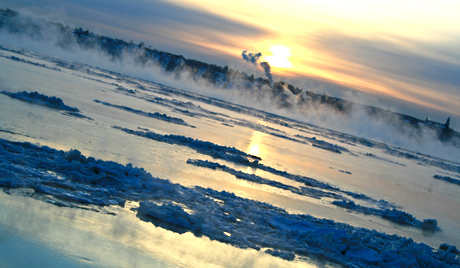 |
November 24, Russia and Canada eye on Arctic
Politicians, scientists and public figures from Russia and Canada have discussed prospects for developing the Arctic and its problems at their meeting in Krasnoyarsk. Over 180 experts took part in the forum.
About 80 percent of the Krasnoyarsk region’s territory is located in the northern latitudes. The northern-most point in Eurasia, Cape Chelyushkin, is located there and the Dickson and Khatanga settlements are known as the gateways to the Arctic. The shortest path to the North Pole starts from here. Consequently, it’s no surprise that the Krasnoyarsk region was chosen as the venue to discuss the future of the Arctic. |
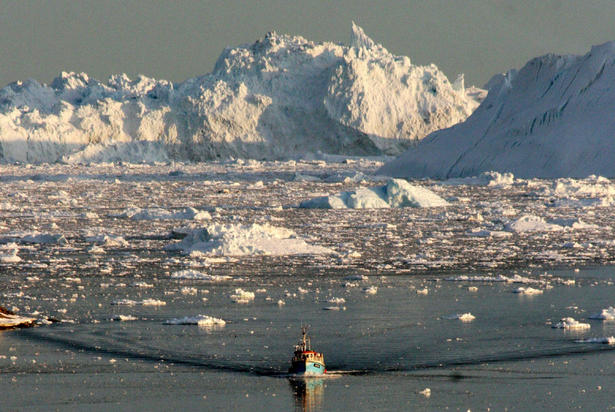 |
November 24, Study finds Arctic sea ice drop greatest, longest in 1,400 years
Research published in a top scientific journal says Arctic sea ice has declined more in the last half-century than it has any time over the last 1,450 years.
The study, which gives the most detailed picture ever of the northern oceans over the previous millennium-and-a-half, also concludes the current decline has already lasted longer than any previous one in that period. |
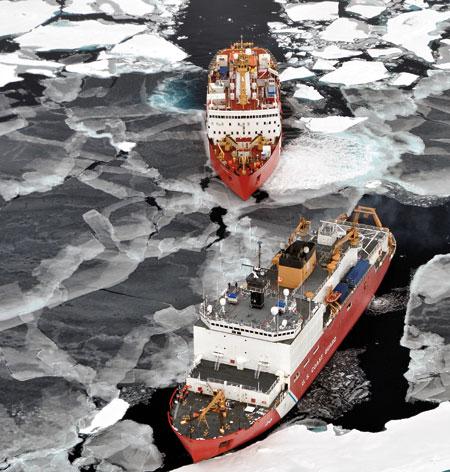 |
November 24, Scientific challenges in the Arctic: Open water
Last month, US researchers took a 4,000-tonne gamble when they steered the Marcus G. Langseth through the Bering Strait and into the Arctic Ocean. The 72-metre research vessel was not built to plow through ice, so it had never ventured that far poleward before.
But the rules are changing quickly in the new north. Managers at the US National Science Foundation (NSF), which owns the ship, decided to send the Langseth into the Arctic after reviewing satellite images that showed that the intended survey area in the Chukchi Sea had been largely clear of ice for four of the past five summers. |
November 23, Climate change episode of Frozen Planet won't be shown in the U.S. as viewers don't believe in global warming
An episode of the BBC's Frozen Planet documentary series that looks at climate change has been scrapped in the U.S., where many are hostile to the idea of global warming.
British viewers will see all seven episodes of the multi-million-pound nature series throughout the Autumn. But U.S. audiences will not be shown the last episode, which looks at the threat posed by man to the natural world. It is feared a show that preaches global warming could upset viewers in the U.S., where around half of people do not believe in climate change. |
 |
November 22, Deciphering Svalbard’s climate history, Swedish Research Finds
At most times of year, you have to be prepared for very low temperatures when staying in Norway’s Arctic archipelago, Svalbard. But the weather is in fact much milder there today than it was in the 1800s. Ice cores drilled from Svalbard’s glaciers are providing important information on the history of its climate.
During the past thousand years, the average winter temperature in Svalbard’s “capital” Longyearbyen has varied from minus 5 degrees Celsius around 1000 AD to minus 25 degrees around 1850. |
November 22, Norway mobilises for oil push into Arctic
Norway unveiled a 20-year plan to unlock offshore Arctic oil and gas resources and channel them to worldwide markets, a project the foreign minister said may cost billions of dollars and bring rivalries over Arctic resources to a head.
"It is the project of a generation," Foreign Minister Jonas Gahr Stoere said in an interview. "As the ice melts, new transport routes are opening up, resources are becoming accessible and human activity is drawn to this region." |
November 22, Vacant Positions at UNIS
The University Centre on Svalbard (UNIS) is a state-owned limited company and has about 350 students annually.
There are about 40 persons on the scientific staff and 25 persons on the technical/administrative staff. In addition there are 24 adjunct professors and about 160 guest lecturers annually. UNIS has four main disciplines: Arctic Biology, Arctic Geology, Arctic Geophysics and Arctic Technology.
|
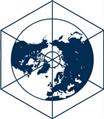 |
November 21, Fifth Polar Law Symposium, Rovaniemi, Finland
The fifth Polar Law Symposium will be held in Rovaniemi, Finland 6-8 September, 2012. Following the great symposium in Nuuk, which included 48 presentations and was attended by both the Icelandic President and Greenlandic Premier, the organizers are aiming high for the symposium in Finland.
This year's symposium will be a cooperative effort between two UArctic Thematic Networks (Arctic Law; Geopolitics and Security) and the Northern Research Forum. More details will be announced soon. |
November 21, Large Differences in the Climate Impact of Biofuels, Swedish Research Finds
When biomass is combusted the carbon that once was bound in the growing tree is released into the atmosphere. For this reason, bioenergy is often considered carbon dioxide neutral. Research at the University of Gothenburg, Sweden, however, shows that this is a simplification. The use of bioenergy may affect ecosystem carbon stocks, and it can take anything from 2 to 100 years for different biofuels to achieve carbon dioxide neutrality.
|
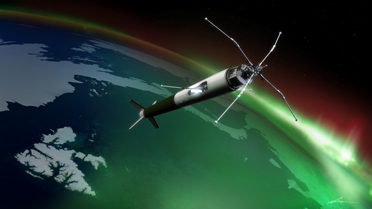 |
November 21, Rocket launch over Svalbard
At some point in the coming two weeks a rocket aimed at the northern lights over Svalbard will be launched from Ny-Alesund.
The ICI-3 rocket is a two-stage sounding rocket with a trajectory designed to intercept the aurora over the archipelago. It will fly for up to 10 minutes and have a maximum altitude of 350 km. The aim of the mission is to look at atmospheric instabilities and waves associated with the daytime northern lights. These disturbances can affect, amongst other things, the accuracy of GPS measurements. |
November 18, Past and present-day ice mass variation on Svalbard revealed by superconducting gravimeter and GPS measurements
We use Superconducting Gravimeter (SG) and Global Positioning System (GPS) measurements from Ny-?lesund, Svalbard, to infer changes in ice mass loss between September 1999 and September 2010. We find that during this period, the gravity rate and vertical crustal velocities are changing with time, adding to evidence about varying rates of ice mass loss. The gravity rate varies through 10 years of observation; -0.23 µGal/yr in 2000–2002, -3.22 µGal/yr in 2002–2005 and -1.10 µGal/yr in 2005–2010. The gravity changes agree well with the observed uplift rates measured by GPS, which are 4.4, 11.3 and 7.4 mm/yr, over the same periods. In addition, we generate model predictions which account for past and present-day ice mass variation. We find that the models under predict both the observed uplift rates and gravity changes.
|
November 18, Absence of Arctic ice affecting weather, global warming
Recent dramatic changes in the Arctic will have a significant effect on our weather in Utah. That's the conclusion of a top scientist studying Arctic sea ice.
Arctic sea ice is disappearing in summer much faster than scientists expected. That's not just evidence of climate change; the ice itself is changing the climate, and it may be affecting weather as far away as Utah. |
 |
November 18, INTERACT Transnational Access Call for Proposals open for Summer Season 2012 and Winter Season 2012/2013
The INTERACT project under EU FP7 has Transnational Access program that offers access to 20 research stations in Northernmost Europe and Russian Federation including:
* Free access for user groups/users to research facilities and field sites, including support for travel and logistic costs * Free access to information and data in the public domain held at the infrastructures |
November 17, Relationships between Arctic shrub dynamics and topographically derived hydrologic characteristics
Shrub expansion is a global phenomenon that is gaining increased attention in the Arctic. Recent work employing the use of oblique aerial photographs suggested a consistent pattern of positive change in shrub cover across the North Slope of Alaska. The greatest amounts of change occurred in valley slopes and floodplains. We studied the association between shrub cover change and topographically derived hydrologic characteristics in five areas in northern Alaska between the 1970s and 2000s. Change in total shrub cover ranged from - 0.65% to 46.56%. Change in floodplain shrub cover ranged from 3.38% to 76.22%. Shrubs are preferentially expanding into areas of higher topographic wetness index (TWI) values where the potential for moisture accumulation or drainage is greater. In addition, we found that floodplain shrub development was strongly associated with high TWI values and a decreasing average distance between shrubs and the river bank.
|
November 17, Svalbard reindeer, a life story
A new report from a 2011 Arctic Field Grant recipient investigates life-history strategies of Svalbard Reindeer.
Researcher Vebj?rn Veiberg from NINA (The Norwegian Institute for Nature Research) has looked into the life of Svalbard reindeer (Rangifer tarandus platyrhynchus). The study examines winter survival of females and fetuses as well as the effect of internal parasites. |
 |
November 17, The secret life of the sea
The ocean is teeming with tiny, exquisite creatures that have concealed themselves in certain ways from scientists. Now, 200 years after the organisms were discovered, Norwegian researchers have started to clear up mysteries from the DNA of radiolarians.
The world is teeming with unknown life forms. In the seas, in the soil – yes even in a shovel full of earth from your garden –innumerable organisms thrive that haven’t been scientifically analyzed and described.
|
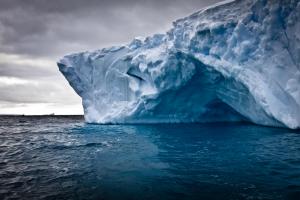 |
November 16, Warm sea currents caused the melting of Greenland’s ice
It was the sea temperature, rather than the air temperature, that determined how fast Greenland’s ice cap melted at the end of the last ice age. This discovery is important for today's research into ice melt.
There was a significant concurrence of high marine temperatures and periods when the Greenlandic ice cap melted at a high rate during the last ice age, a climate history study shows. |
November 16, Erratic, Extreme Day-To-Day Weather Puts Climate Change in New Light
The first climate study to focus on variations in daily weather conditions has found that day-to-day weather has grown increasingly erratic and extreme, with significant fluctuations in sunshine and rainfall affecting more than a third of the planet.
Princeton University researchers recently reported in the Journal of Climate that extremely sunny or cloudy days are more common than in the early 1980s, and that swings from thunderstorms to dry days rose considerably since the late 1990s. |
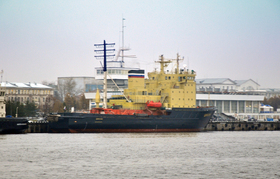 |
November 15, Russia to boost investments in the Arctic
Russia’s President Dmitry Medvedev pledges to boost Arctic research and exploration amid tough competition from other nations to the region’s natural resources.
We are simply committed to continue research of the Arctic Ocean and the Arctic in general, because if we fail to do this, other countries will take control, Medvedev said on Friday |
November 15, Nordic research gets new window to the world
A new web site presenting news on research in the Nordic countries has recently been launched.
ScienceNordic is an English language news site for scientific news from the Nordic countries Denmark, Norway, Sweden, Finland and Iceland.
|
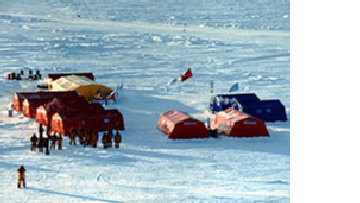 |
November 14, The Arctic and Responsible Adaptation to Climate Change
Sea ice coverage in the Arctic shrank this summer to the second-lowest level ever measured, and an energy and mineral rush is gathering steam in pursuit of nearly a quarter of the world's oil and gas. Meanwhile, a tanker ship has just set the speed record for crossing the Arctic sea in 6.5 days.
At the same time, Vladimir Putin, prime minister of the country with the most Arctic territory, has proclaimed that the Arctic Ocean is going to rival the Suez Canal as a trade route, and that we are upon an era of Arctic industrialization. Even China -- with no Arctic land of its own -- is making significant investments to explore the region, which has a vast expanse of international waters that is for the first time becoming navigable. |
November 14, Obama, Norwegian PM meet to discuss Arctic policy
On October 20, President Barack Obama and Norwegian Prime Minister Jens Stoltenberg met at the White House in Washington, D.C. They discussed issues such as Norway's involvement in the campaigns in Libya and Afghanistan, and the domestic terrorist attacks in July. One other issue they also discussed was the High North.
In their joint remarks in the Oval Office after their 45-minute meeting, Stoltenberg said: "I appreciate also very much that we had the opportunity to focus on the High North. The High North is a area where we are seeing new possibilities, new challenges, but also new dangers. |
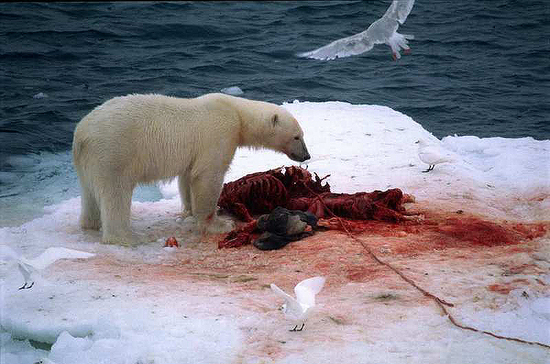 |
November 11, Alarm: Ice free North Pole by 2015
Arctic Sea ice is shrinking so rapidly that by the summer in as little as four years’ time it could vanish altogether at the top of the globe. The International Energy Agency warns that climate change is irreversible by 2017.
Polar bears could be robbed of their hunting ground in the summer period and will hardly survive as the rising global temperature puts the Arctic sea ice in a death spiral. Polar bears totally depend on the sea ice when hunting seals.
|
November 11, Murmansk fishers to deliver catch to Svalbard
Arktikugol has suggested that fishers from Murmansk should deliver fresh fish to the Russian settlement on Svalbard.
The fisheries sector in Murmansk is looking forward to the possibility of delivering fish to the Arctic archipelago of Svalbard, something they have not been able to do since the Soviet times... |
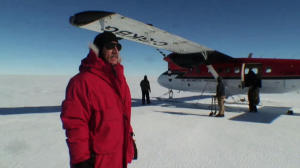 |
November 10, International Team to Drill Beneath Massive Antarctic Ice Shelf
An international team of researchers funded by NASA and the National Science Foundation (NSF) will travel next month to one of Antarctica's most active, remote and harsh spots to determine how changes in the waters circulating under an active ice sheet are causing a glacier to accelerate and drain into the sea.
|
November 10, Cooperating with China on research project AMORA
The Chinese-Norwegian research project “Advancing Modeling and Observing Solar Radiation of Arctic Sea Ice” (AMORA) aims to develop measuring devices which will contribute to a better understanding of the Sun’s impact on global warming. As part of this cooperation, the nations are also exchanging scientists.
|
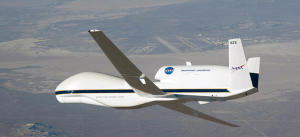 |
November 10, Scientists Prepare for Coming ATTREX Climate Study
A consortium of scientists are in the early stages of preparation for a multi-year airborne science campaign to study the humidity and chemical composition of air entering the tropical tropopause layer of the atmosphere between eight and 11 miles (13 to 18 km) high. NASA's Airborne Tropical Tropopause Experiment, or ATTREX, will conduct this research over the Pacific Ocean from three locations in 2013 and 2014.
|
 |
November 9, Understanding Ice Formation in Arctic Clouds
Shallow, persistent cloud layers that contain both liquid droplets and ice crystals are common in the Arctic. With cloud tops warmer than -38 degrees Celsius, ice formation depends on aerosols that preferentially freeze at warm temperatures, referred to as ice nuclei. However, past studies of such Arctic mixed-phase clouds have been unable to explain the measured abundance of ice crystals larger than 100 micrometers in maximum dimension (the size range where measurements are available), given observed environmental conditions and the measured concentrations of ice nuclei that could be entrained into the observed shallow cloud layers from aloft. Several studies were able to roughly reproduce the observed ice distributions, but only by invoking novel mechanisms for ice formation or by including sources of ice nuclei not confirmed by the measurements.
|
November 9, NASA Airborne Mission Maps Remote, Deteriorating Glaciers
NASA's airborne expedition over Antarctica this October and November has measured the change in glaciers vital to sea level rise projections and mapped others rarely traversed by humans.
Operation IceBridge, nearing completion of its third year, is the largest airborne campaign ever flown over the world's polar regions. Bridging a gap between two ice elevation mapping satellites, and breaking new scientific ground on its own, IceBridge this fall has charted the continued rapid acceleration and mass loss of Pine Island Glacier. |
November 9, Discrepancies between MODIS and ISCCP land surface temperature products analyzed with microwave measurements
This paper compares land surface temperature (LST) products from the Moderate Resolution Imaging Spectroradiometer (MODIS) and the International Satellite Cloud Climatology Project (ISCCP). With both sources, the LST data are derived from infrared measurements. For ISCCP, LST is a secondary product in support of the primary cloud analyses, but the LST data have been used for several other purposes. The MODIS measurements from the Aqua spacecraft are taken at about 01:30 and 13:30 local time, and the ISCCP three-hourly data, based on several geostationary and polar orbiting satellites, were interpolated to the MODIS measurement times.
|
November 8, Dynamic patterns of ice stream flow in a 3-D higher-order ice sheet model with plastic bed and simplified hydrology
Predicting ice sheet mass balance is challenging because of the complex flow of ice streams. To address this issue, we have coupled a three-dimensional higher-order ice sheet model to a basal processes model where subglacial till has a plastic rheology and evolving yield stress. The model was tested for its sensitivity to regional water availability. First, with an assumed undrained bed, the ice stream oscillates between active and stagnant phases, solely as a result of thermodynamic feedbacks occurring at the ice-till interface. However, the velocity amplitude decreases over time, as insufficient basal meltwater causes the ice stream to gradually thicken and enter a slow flowing “ice sheet mode.” Second, we assume that the till is able to assimilate water from a hypothetical regional hydrological system. This leads to significantly different long-term behavior, as a continuously oscillating “ice stream mode” is maintained.
|
November 8, Times Atlas map of Greenland to be corrected
We were pleased to hear from the University of Arizona’s Jeff Kargel that the Times Atlas folks are now updating their atlas of Greenland. As we reported earlier, the first edition was completely in error, and led to some rather bizarre claims about the amount of ice loss in Greenland. Kargel reports that HarperCollins (publisher of the Times Atlas) has now fully retracted their error and has produced a new map of Greenland that will be made available as a large-format, 2-side map insert for the Atlas and will also be available free online. Meanwhile, Kargel and colleagues have produced their own updated small-scale map and have written a paper that includes both their new map and a description of the incident that led up to it.
|
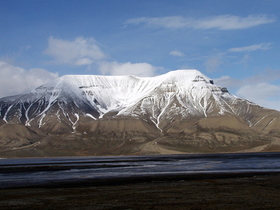 |
November 8, Norway’s view on Svalbard
Following the increasing international focus on the maritime areas surrounding Svalbard, the Norwegian Ministry of Foreign Affairs has published comprehensive back-ground material.
The publication is produced in cooperation with the Norwegian Polar Institute, the University Centre in Svalbard, SINTEF, the Norwegian University of Science and Technology and the Norwegian Ministry of Foreign Affairs. |
November 7, Toxin levels in gull blood
With support from the Arctic Field Grant, master Student Anja Johansen Haugerud from the spent two summer weeks on Svalbard taking samples from Glaucous gulls.
In connection with the Fram Center flagship "Environmental toxins - effects on ecosystems and health", master student Anja Johansen Haugerud from the Norwegian Polar Institute and Norwegian University of Science and Technology took blood samples from and attached loggers to Glaucous gulls in the Kongsfjorden area. The goal; to measure the amount of environmental toxins that accumulate in the gulls and subsequently their eggs. |
November 7, Five Coming Innovations in Arctic Science
Scientific tools have come a long way from the simple, leather-bound journals 18th century naturalists were toting on expeditions into uncharted lands. But hundreds of years later, we are still asking many of the same questions about the natural world: what’s out there and how does it work?
A handful of adventurous researchers have been probing the northern frontiers of the Arctic Circle for decades, and last week, I was fortunate enough listen in as they offered their knowledge of this region to the experts at NOAA who specialize in marine oil spill preparedness and response. |
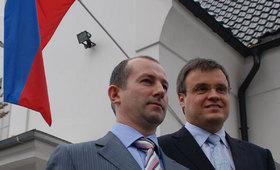 |
November 3, - Nothing to do with Spitsbergen dispute
The exclusion of Norwegian salmon exporters from the Russian market has nothing to do with the recent detention of Russian trawlers in the waters around Spitsbergen, leaders of Russian fishery unions underline.
Speaking at a seminar organized by the Russian Fish Union in Oslo yesterday, union leaders categorically rebuffed speculations about an alleged link between the detention of Russian trawlers in the Spitsbergen waters and the expulsion from the Russian market of Norwegian fish exporters. |
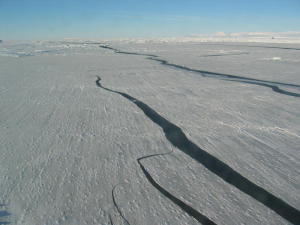 |
November 3, Scientists Predict Faster Retreat for Antarctica's Thwaites Glacier; Underwater Ridge Critical to Future Flow
The retreat of Antarctica's fast-flowing Thwaites Glacier is expected to speed up within 20 years, once the glacier detaches from an underwater ridge that is currently holding it back.
Thwaites Glacier, which drains into west Antarctica's Amundsen Sea, is being closely watched for its potential to raise global sea levels as the planet warms. Neighboring glaciers in the Amundsen region are also thinning rapidly, including Pine Island Glacier and the much larger Getz Ice Shelf. |
November 2, Denmark welcomes China in from the Arctic cold
China has legitimate economic interests in the Arctic, Denmark's ambassador said on Friday, welcoming partnership with Beijing in the rapidly thawing polar region but adding that a possible resource rush would come with obligations.
With climate change linked to melting ice caps in the Arctic, the prospect of untapped hydrocarbons, fishing grounds and new summer shipping lanes has whetted China's appetite for polar research and exploration capabilities.
|
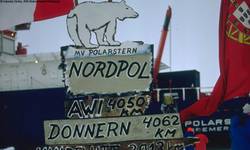 |
November 2, Arctic for All?
With the prospect of new raw materials and trade routes, the geopolitical significance of the North Pole is growing. International cooperation is becoming increasingly important in the region.
Climate change in the Arctic is a catastrophe waiting to happen. This 20 million square kilometre area of land and sea that stretches around the geographic North Pole is warming twice as fast as the global average. The complexity of the impacts on global climate, rising sea levels and ocean currents are still barely foreseeable. |
November 2, NSF grant will help deepen our understanding of Arctic climate change
Daniel Jacob, Vasco McCoy Family Professor of Atmospheric Chemistry and Environmental Engineering in the Harvard School of Engineering and Applied Sciences (SEAS), is the lead primary investigator of a grant for $477,787 to develop an improved understanding of the distributions and decadal trends of aerosols and ozone in the Arctic and study the implications for Arctic climate change during 1980-2010.
|
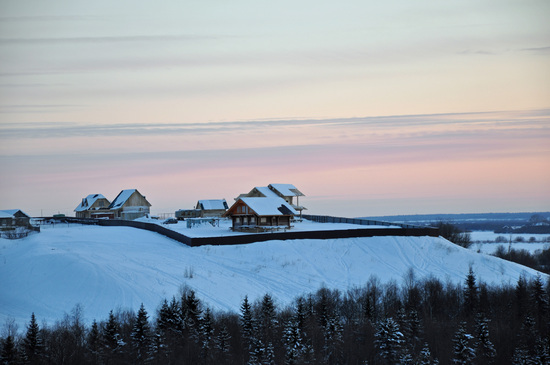 |
November 1, Russia to make law on Arctic territories
Russia’s Arctic territories will become a separate object of state policy. A federal law on this subject is expected to be prepared in 2012.
- The place and role of the northern territories in the country’s socio-economic development pre-determine the need to single out the Arctic zone as a separate object of state policy, a draft concept of the law reads. |
November 1, Cold Winters: Arctic Sea Ice.
The importance of Arctic sea-ice in Northern Hemisphere atmospheric circulation is well established. The driving force of the circulation of the atmosphere is the pole to equator temperature gradient, flows being modified by geography and the spin of the Earth. However the impacts of the radical reduction in Arctic sea-ice that have been seen in the last decade are only now being fully appreciated, with ongoing research details are becoming more clear. Amongst these impacts there is the prospect for a contribution of reduced sea-ice to colder winters in the Northern Hemisphere.
|
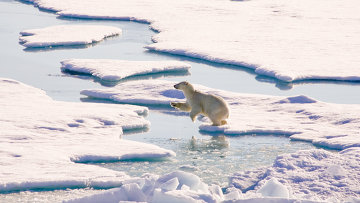 |
October 31, Facebook joins the Arctic crowd
The northern Scandinavian landscape is dotted with fjords, lingonberries and, if you believe some locals, elves. But another sight is increasingly common on the Arctic horizon: data centers.
Drawn by the promise of lower electricity costs, a growing number of tech companies are harnessing the region's abundant cold air to cool their servers, cutting expensive air-conditioning out of the equation. Facebook, the latest tech company to take the polar plunge, announced this week that it will build a data center just south of the Arctic Circle in Lulea, Sweden, where the average low in January is 3 degrees Fahrenheit. The facility, a set of three 300,000 square foot buildings, is the social networking site's first data center outside the U.S. It's scheduled to be operational by 2012. |
October 31, China enters the Arctic equation
A new Great Game is making a quiet appearance in Canada’s Arctic.
In a speech Friday in Beijing, the Danish ambassador to China, Friis Arne Peterson, said the communist country has “natural and legitimate economic and scientific interests in the Arctic” even though it lacks a coastline in the rapidly thawing polar region.
He went on to say that his government would like to see China given permanent observer status in the eight-member Arctic Council, which currently includes Canada, Russia, Denmark, Finland, Iceland, Sweden and the United States. China has applied to become a permanent observer in the forum. |
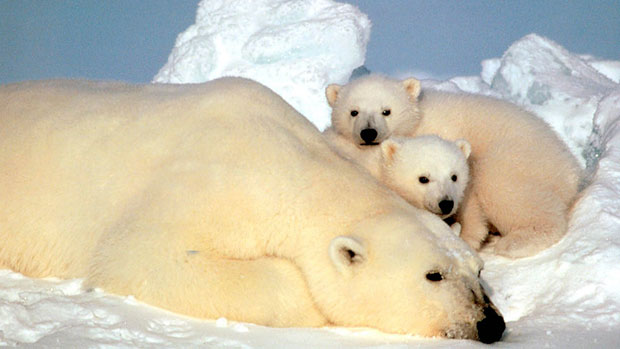 |
October 28, Circumpolar countries to work on polar bear plan
Circumpolar countries want to make sure the polar bear will survive in a changing Arctic.
Two years from now, Canada will work with Norway, Russia, the U.S. and Greenland on an international plan to protect and research the animals.
First, countries will complete their own management plans.
One of the last presentations was from an Iqaluit elder and member of the Qikiqtaaluk Wildlife Board. |
October 28, Implementation of the Coupled Ocean-Atmosphere Response Experiment flux algorithm with CO2, dimethyl sulfide, and O3
Updates for the Coupled Ocean-Atmosphere Response Experiment (COARE) physically based meteorological and gas transfer bulk flux algorithms are examined. The current versions are summarized and a generalization of the gas transfer codes to 79 gases is described. The current meteorological version COARE3.0 was compared with a collection of 26,700 covariance observations of drag and heat transfer coefficients (compiled from three independent research groups). The algorithm agreed on average to within 5% with observations for a wind speed range of 2 to 18 m s-1. Covariance observations of CO2 and dimethyl sulfide (DMS) gas transfer velocity k were normalized to Schmidt number 660 and compared to an ensemble of gas flux observations from six research groups and nine field programs.
|
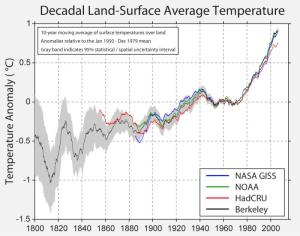 |
October 28, Cooling the Warming Debate: Major New Analysis Confirms That Global Warming Is Real
Global warming is real, according to a major study released Oct. 20. Despite issues raised by climate change skeptics, the Berkeley Earth Surface Temperature study finds reliable evidence of a rise in the average world land temperature of approximately 1°C since the mid-1950s.
|
October 27, Recent land surface air temperature trends assessed using the 20th Century Reanalysis
Land surface air temperature trends observed during 1979–2008 are compared with those simulated by the 20th Century Reanalysis that is driven only by observed sea surface temperatures and sea ice, atmospheric CO2 concentrations, solar and volcanic forcings, and surface pressure data. On a global annual average, the 20th Century Reanalysis simulates a little more than 80% of the observed trend, but with substantial regional and seasonal variations. The remainder of the trend may be ascribed tentatively to land use changes, aerosol increases and decreases, and changes in minor greenhouse gases not accounted for in the 20th Century Reanalysis.
|
October 27, Decadal to seasonal variability of Arctic sea ice albedo
A controlling factor in the seasonal and climatological evolution of the sea ice cover is its albedo a. Here we analyze Arctic data from the Advanced Very High Resolution Radiometer (AVHRR) Polar Pathfinder and assess the seasonality and variability of broadband albedo from a 23 year daily record. We produce a histogram of daily albedo over ice covered regions in which the principal albedo transitions are seen; high albedo in late winter and spring, the onset of snowmelt and melt pond formation in the summer, and fall freezeup. The bimodal late summer distribution demonstrates the combination of the poleward progression of the onset of melt with the coexistence of perennial bare ice with melt ponds and open water, which then merge to a broad peak at a > 0.5.
|
 |
October 26, A vision for a Russian domed city in the Arctic
Russia is known for its domes, which generally sit on top of Orthodox churches. Soon, one might be on top of the world in Russia’s neck of the Arctic, this time sitting atop a city. During the Arctic: Territory of Dialogue conference last month in Murmansk, Putin reviewed plans and mock-ups for a a 5,000-person domed village in the Arctic called Umka, named after a popular cartoon polar bear in Russia. The village would be tiny, covering only 1.2 square kilometers of land on Kotelny, the largest of the New Siberian Islands. Yet despite its small size, the Daily Mail quoted architect Valery Rzhevskiy as saying, “This city will be of strategic importance as Russia’s northern outpost.” In fact, lying 1,000 miles from the North Pole, Umka would become Russia’s northernmost settlement, though it would still fall shy of the record. That belongs to Alert, Nunavut, a permanently inhabited weather station and military intelligence facility 508 miles from the North Pole. However, Alert only has five permanent residents, so Umka would have a population one thousand times larger.
|
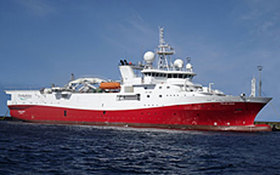 |
October 26, More seismic data from the Barents Sea
The companies Dolphin Geophysics and TGS are collecting 3D seismic data from a 1500 square km big area in the Barents Sea.
The mapping takes place in an area north of the North Cape |
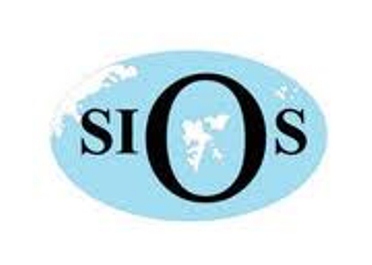 |
October 25, We have the questions do you have the answers?
In order to complete work package 5 of SIOS information on field stations, equipment and infrastructure is needed. For that your help is needed.
Piotr Glowacki - Responsible for WP5 has send out the following letter to all SIOS partners. If your institution has not filled in the questionnaire please help to see that it is done. |
October 25, IEA releases latest statistics on global CO2emissions
Due to the 2008-2009 economic crisis global CO2emissions decreased for the first time since 1990, but a large rebound is anticipated in 2010
While carbon dioxide emissions in non-Annex I countries continued to grow in 2009 (+3.3%), emissions of Annex I countries fell sharply (-6.5%), according to a new publication from the International Energy Agency. Most of the reduction, however, comes from a decrease in the energy consumption due to the 2008-2009 economic crisis.
Statistics for 2009 show that emission levels for the group of countries participating in the Kyoto Protocol – a multinational agreement to mitigate climate change – were just shy of 15% below their 1990 level. |
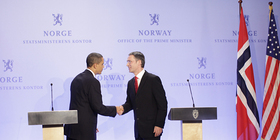 |
October 24, Obama and Stoltenberg discussed the High North
The High North was one of the issues up for discussion when Norway’s Prime Minister Jens Stoltenberg med with U.S. President Barack Obama in the White House on Thursday.
The two leaders discussed possibilities for cooperation in the Arctic Ocean, especially on fields like emergency preparedness and search and rescue operations. - The U.S. looks at the development in the High North with great interest, and wants to develop our cooperation, also within the oil and gas sector, Stoltenberg said after the meeting. |
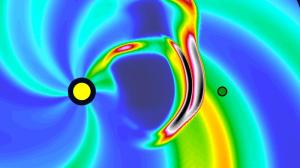 |
October 24,Space Weather Prediction Model Improves Forecasting
NOAA is now using a sophisticated forecast model that substantially improves predictions of space weather impacts on Earth. Better forecasts offer additional protection for people and the technology-based infrastructure we use daily.
|
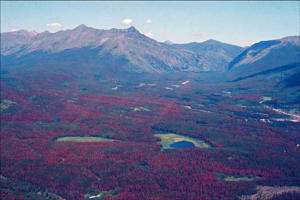 |
October 24, 'Albedo Effect' in Forests Can Cause Added Warming, Bonus Cooling
Wildfire, insect outbreaks and hurricanes destroy huge amounts of forest every year and increase the amount of carbon dioxide entering the atmosphere, but scientists are now learning more about another force that can significantly affect their climate impact.
Researchers conclude in a new study that the albedo effect, which controls the amount of energy reflected back into space, is important in the climatic significance of several types of major forest disturbances. |
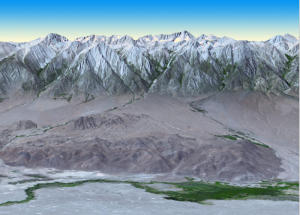 |
October 24, Trans-Arctic cable to go via Murmansk
A Trans-Arctic fiber optic line connecting Tokyo and London is planned to go through Murmansk.
The Russian company Polarnet Project plans the construction of a Russian trans-Arctic cable line, Rotax, with the cost of nearly $2 billion. The Governmental Commission for Federal Communications and Technological Issues approved the project last Friday. |
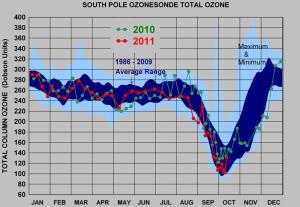 |
October 24, Significant Ozone Hole Remains Over Antarctica
The Antarctic ozone hole, which yawns wide every Southern Hemisphere spring, reached its annual peak on September 12, stretching 10.05 million square miles, the ninth largest on record. Above the South Pole, the ozone hole reached its deepest point of the season on October 9 when total ozone readings dropped to 102 Dobson units, tied for the 10th lowest in the 26-year record.
|
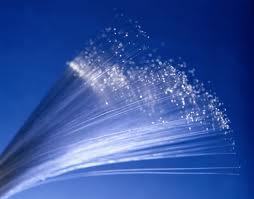 |
October 20, Trans-Arctic cable to go via Murmansk
A Trans-Arctic fiber optic line connecting Tokyo and London is planned to go through Murmansk.
The Russian company Polarnet Project plans the construction of a Russian trans-Arctic cable line, Rotax, with the cost of nearly $2 billion. The Governmental Commission for Federal Communications and Technological Issues approved the project last Friday. |
October 20, Russia to spend 1.1 billion rubles on Arctic research in 2012-2013
The Russian government intends to spend 1.13 billion rubles on research in the Arctic and Antarctic, environmental monitoring and infrastructure development, the Russian Finance Ministry said on its website.
Under a new budget spending plan, in 2012 Russia will spend 456.5 million rubles on research, the construction of communication systems, environment monitoring and other projects under the Arctic Development subprogram. In 2013, 370.07 million rubles will be spent. |
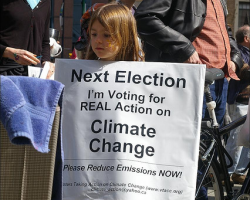 |
October 20, Climate Change and Our Generation: A Legacy We’re Shaping
The 2012 election is heating up, and the issues at stake are more relevant than ever. A number of them are incredibly important to our generation-youth unemployment, deficits, education, student loan debt, foreign policy, and more. We’re breaking them down, giving them context, discussing possible solutions, interviewing experts, and- above all- showcasing the takes of students nationwide. Welcome to ‘NextGen Policy’- a NGJ special series. In the arena today: climate change.
|
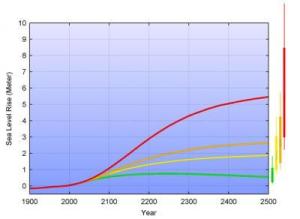 |
October 19, Sea Levels to Continue to Rise for 500 Years? Long-Term Climate Calculations Suggest So
Rising sea levels in the coming centuries is perhaps one of the most catastrophic consequences of rising temperatures. Massive economic costs, social consequences and forced migrations could result from global warming. But how frightening of times are we facing? Researchers from the Niels Bohr Institute are part of a team that has calculated the long-term outlook for rising sea levels in relation to the emission of greenhouse gases and pollution of the atmosphere using climate models.
|
October 19, Recent changes in shelf hydrography in the Siberian Arctic: Potential for subsea permafrost instability
Summer hydrographic data (1920–2009) show a dramatic warming of the bottom water layer over the eastern Siberian shelf coastal zone (<10 m depth), since the mid-1980s, by 2.1°C. We attribute this warming to changes in the Arctic atmosphere. The enhanced summer cyclonicity results in warmer air temperatures and a reduction in ice extent, mainly through thermodynamic melting. This leads to a lengthening of the summer open-water season and to more solar heating of the water column.
|
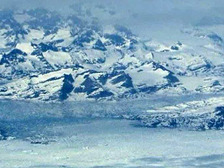 |
October 19, Antarctic lake mission targets life and climate signs
A pioneering British expedition to sample a lake under the Antarctic ice hopes to find unknown forms of life and clues to future climate impacts.
The mission will use hot water to melt its way through ice 3km (2 miles) thick to reach Lake Ellsworth, which has been isolated from the outside world for at least 125,000 years - maybe a million. The team hopes to be the first to sample a sub-glacial Antarctic lake. An engineering team leaves the UK later this week along with 70 tonnes of gear. |
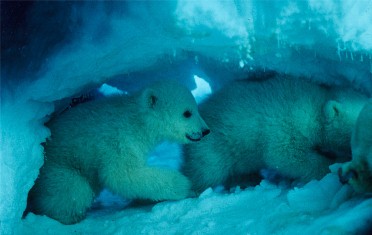 |
October 18, The mother bears are back!
Polar bears in Svalbard are reclaiming denning areas that were abandoned prior to their complete protection in 1973.
A recent study by researchers at the Norwegian Polar institute looks into polar bear denning data from 1973 to 2010. Encouragingly it clearly shows that the 1973 hunting ban on bears have had a positive effect on the distribution of dens in the archipelago. While most of the denning still takes place in the east more and more bears are born in locations that have not been used for denning in decades. Presumably the dens were abandoned due to the massive hunting pressure in the northern and western part of Svalbard. |
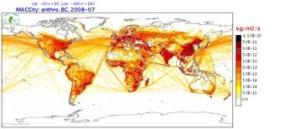 |
October 18, Emissions of Atmospheric Compounds: New Scenarios for the IPCC
Emissions of the main greenhouse gases, reactive gaseous and particulate chemical compounds have been inventoried over the period 1850-2300 by an international collaboration involving scientists from the Laboratoire "Atmospheres, Milieux, Observations Spatiales". This quantification has enabled researchers to propose four new scenarios that will be used in future climatic simulations of the 5th IPCC report, due in 2013.
|
October 17, A mass conservation approach for mapping glacier ice thickness
The traditional method for interpolating ice thickness data from airborne radar sounding surveys onto regular grids is to employ geostatistical techniques such as kriging. While this approach provides continuous maps of ice thickness, it generates products that are not consistent with ice flow dynamics and are impractical for high resolution ice flow simulations. Here, we present a novel approach that combines sparse ice thickness data collected by airborne radar sounding profilers with high resolution swath mapping of ice velocity derived from satellite synthetic-aperture interferometry to obtain a high resolution map of ice thickness that conserves mass and minimizes the departure from observations.
|
October 17,Scientists set Franz Josef Land clean-up schedule
The most dangerous environmental pollutants on Franz Josef Land will be removed and recycled in the first place as part of a major cleanup of the Arctic, Marina Nekrasova, leading research associate of the Production Forces’ Research Council (SOPS) said.
|
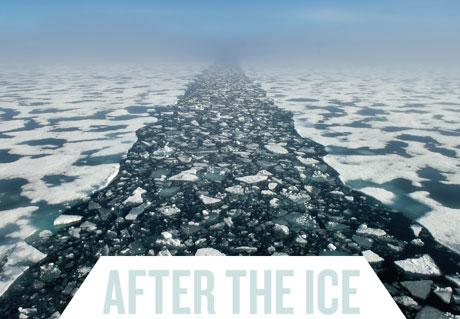 |
October 14, Special issue on the Arctic: After the ice
UAs the Arctic thaws, can science help to chart a sustainable path for the north?
Last winter, parts of the Canadian Arctic basked in record-breaking warmth. In the town of Coral Harbour, at the mouth of Hudson Bay, temperatures rose above freezing for a few days in January for the first time ever. Across the Arctic, extreme climate conditions are becoming the norm, even as the region faces other profound changes, such as the growing political power of indigenous peoples and the race to extract mineral resources |
 |
October 14, Redrawing the Arctic map: The new north
Getting to grips with a changing polar landscape.
The Arctic covers around 5% of the planet's surface, but it is capturing a disproportionate amount of attention. With temperatures rising at twice the global rate, the region's summer sea ice is shrinking rapidly, making access easier than ever before. At the same time, countries are racing to claim parts of the Arctic's sea floor and the vast deposits of hydrocarbons that lie beneath it. |
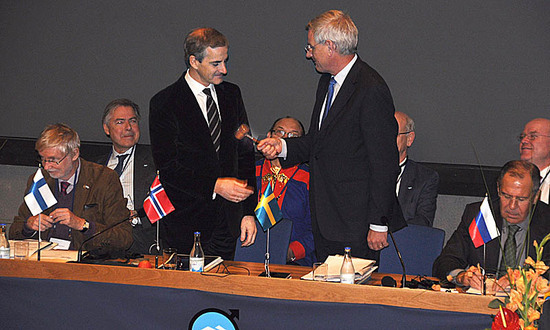 |
October 13, Natural and human resources in focus
KIRUNA: Economic and industrial development, protection of the environment and people-to-people cooperation are the main priorities for Norway’s chairmanship in the Barents Euro-Arctic Council.
- The people-to-people cooperation is what makes the Barents region unique, said St?re after receiving the chairmanship gavel from Bildt. - One of the greatest achievements in the 18 years long history of the Barents cooperation is the normalization of human contact across the borders. |
October 13, Historical Norwegian-Russian meeting
We intend to strengthen our cooperation in the High North with joint initiatives both on land and in the air, Norwegian Chief of Defence said after his historical visit to Moscow yesterday.
It is the first time ever that a Norwegian Chief of Defence visits Russia. On the invitation of his Russian counterpart, General Harald Sunde this week paid a visit to Moscow. |
October 12, SPE Arctic: AEE 2011 Moscow is Center Stage for Key Arctic Dialogue
Having the world's longest Arctic coastline, Russia lays claim to the greatest volume of undeveloped hydrcarbon reserves in the world - a 21st Century "sweet spot" if you will. So this month, SPE, together with Reed Exhibitions, invites specialists from around the world to Moscow for its first Arctic & Extreme Environments Exhibition & Conference. The event takes place 18 to 20 October in the All-Russian Exhibition Center.
The three-day expo will host representatives of dozens of Russian and foreign oil companies and service companies including BP, Rosneft, Total, Gasprom, Halliburton, Baker Hughes and others. The conference is co-chaired by TNK-BP deputy president Sergei Brezitsky and professor of Gubkin Russian State University of Oil and Gas Anatoly Zolotukhin. “We would like to address issues during this conference, to address, rather then resolve,” Zolotukhin said in in his welcoming video address to the conference, posted on its official site. |
October 12, Piles of waste metal must be scrapped to save archipelago ecology
Over 400,000 oil drums must be scrapped and collapsing depots and leaking fuel depots must be removed in order to ecologically rehabilitate the Arctic archipelago Franz Josef Land.
This means that over 27,000 tons of waste metal must be scrapped. This was said on Thursday at a news conference, devoted to first results of an expedition to the archipelago within the framework of the “Ecological Rehabilitation of the Arctic Region” programme. The main environmental problem of the region is hundreds of thousands of metal barrels for petroleum products, tons of metal scrap and different kinds of broken down hardware. |
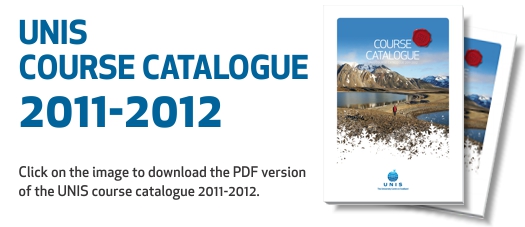 |
October 12, UNIS Course Catalogue 2011-2012
UNIS offers courses at the undergraduate and graduate level in four fields: Arctic Biology (AB), Arctic Geology (AG), Arctic Geophysics (AGF) and Arctic Technology (AT).
Full semester studies are available at the undergraduate level (200-level). At the graduate level (300-level) UNIS offers shorter and more intensive courses spanning from a few weeks up to a semester. |
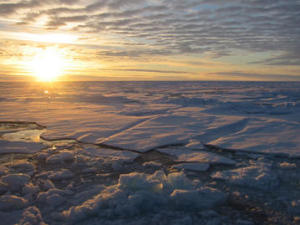 |
October 11, Why Climate Models Underestimated Arctic Sea Ice Retreat: No Arctic Sea Ice in Summer by End of Century?
In recent decades, Arctic sea ice has suffered a dramatic decline that exceeds climate model predictions. The unexpected rate of ice shrinkage has now been explained by researchers at CNRS, Universit? Joseph Fourier and Massachusetts Institute of Technology. They argue that climate models underestimate the rate of ice thinning, which is actually about four times faster than calculations. This model bias is due to the poor representation of the sea ice southward drift out of the Arctic basin through the Fram Strait. When this mechanism was taken into account to correct the discrepancy between simulations and observations, results from the new model suggested that there will be no Arctic sea ice in summer by the end of the century.
|
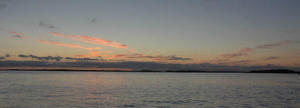 |
October 11, Baltic Sea Contributes Carbon Dioxide to the Atmosphere, Study Shows
The Baltic Sea emits more carbon dioxide than it can bind. Local variations have increased the exposure of the Bay of Bothnia. These are the results from a study of how carbon dioxide flows between the water of the Baltic Sea and the atmosphere, carried out by scientists at the University of Gothenburg, Sweden.
|
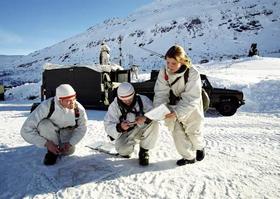 |
October 10, State budget emphasizes northern regions
Norway will use more money on petroleum activities and security issues in the High North. This became evident through the state budget that was presented on Thursday.
The Norwegian Government allocates NOK 180 million to seismic exploration near Jan Mayen and in the newly established border area to Russia in the Barents Sea. This is nearly 30 percent more than the previous year. In addition, another NOK 84 million goes to seismic explorations and collection of data in the Norwegian Sea and the southern parts of the Barents Sea. |
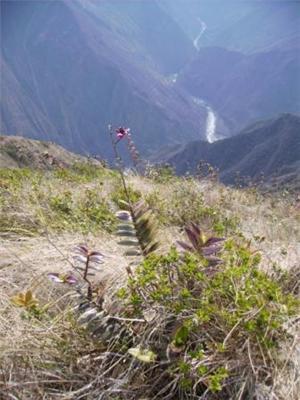 |
October 10, Ancient Climate Change Has Left a Strong Imprint On Modern Ecosystems
As Earth’s climate cycles between warm and cool periods, species often must move to stay within suitable conditions. Scientists have now mapped how fast species have had to migrate in the past to keep up with changing climate. They found that small-ranged species – which constitute much of Earth’s biodiversity – are concentrated in regions where little migration has been required. Climate change due to human activities will drastically increase the required migration rates in many of these locations, putting their unique faunas at risk.
|
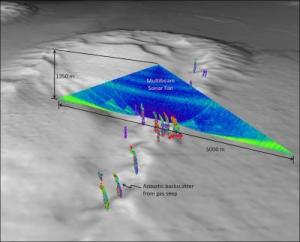 |
October 10,
Multibeam Sonar Can Map Undersea Gas Seeps
A technology commonly used to map the bottom of the deep ocean can also detect gas seeps in the water column with remarkably high fidelity, according to scientists from the University of New Hampshire and the National Oceanic and Atmospheric Administration (NOAA). This finding, made onboard the NOAA ship Okeanos Explorer in the Gulf of Mexico, will lead to more effective mapping of these gas seeps and, ultimately, enhanced understanding of our ocean environments.
|
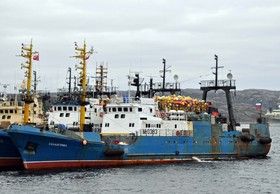 |
October 7, Russia wants to discuss Svalbard Fisheries Protection Zone
The Russian state Fishery Directorate wants to discuss the situation in the Fisheries Protection Zone around Svalbard at the next meeting in the Norwegian-Russian Joint Fishery Commission.
|
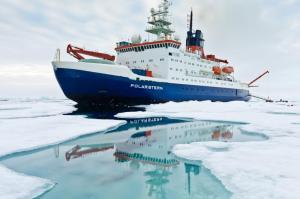 |
October 7, Young and Thin Instead of Old and Bulky: Researchers Report On Changes in Arctic Sea Ice After Return of Research Vessel Polarstern
In the central Arctic the proportion of old, thick sea ice has declined significantly. Instead, the ice cover now largely consists of thin, one-year-old floes. This is one of the results that scientists of the Alfred Wegener Institute for Polar and Marine Research in the Helmholtz Association brought back from the 26th Arctic expedition of the research vessel Polarstern.
|
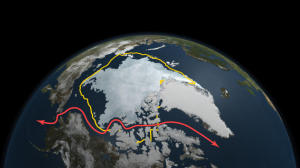 |
October 7, Arctic Sea Ice Continues Decline, Hits Second-Lowest Level
Last month the extent of sea ice covering the Arctic Ocean declined to the second-lowest extent on record. Satellite data from NASA and the NASA-supported National Snow and Ice Data Center (NSIDC) at the University of Colorado in Boulder showed that the summertime sea ice cover narrowly avoided a new record low.
|
October 6, Increasingly Precise Data On Radiation Reflected from the Arctic Sea Area
The Finnish Meteorological Institute has developed a new, globally unique method for estimating surface albedo in the Arctic sea area solely on the basis of microwave data. Its advantage over conventional optical methods is that neither clouds nor darkness interfere with measurements.
|
October 6, Melting Arctic ice clears the way for supertanker voyages
Scandinavian shipowners say cargo routes through the Arctic, made possible by warmer temperatures, would save money and emissions.
Supertankers and giant cargo ships could next year travel regularly between the Atlantic and Pacific Oceans via the Arctic to save time, money and emissions, say Scandinavian shipowners. |
October 5, Russia signs international Arctic projects agreement
Russia signed an agreement on Tuesday on international funding for co-financing nature conservation projects operating under the Arctic Council.
The agreement was signed by Russia's Natural Resources Minister Yury Trutnev and Managing Director of Nordic Environment Finance Corporation (NEFCO) Magnus Rystedt. This agreement started the work of the first international fund for co-financing nature conservation projects operating under the Arctic Council. The aim of the fund, the Project Support Instrument (PSI), is to finance Arctic Council member states helping to protect the Arctic environment. Russia was the first Arctic Council member state to accept the new instrument. |
October 5, Russia's new floating station starts work in Arctic
A new Russian manned drifting weather station started operating in the Arctic Ocean on Saturday.
The Severny Polyus-39 (SP-39) floating station officially began its work after a ceremony to hoist the Russian flag on Saturday afternoon. The station has already sent its first weather report.
|
October 4, Russian scientific stations in the Arctic
In 1875, an Austrian geophysicist named Karl Weyprecht proposed polar stations to conduct year-round observations using consistent methods and instruments...
|
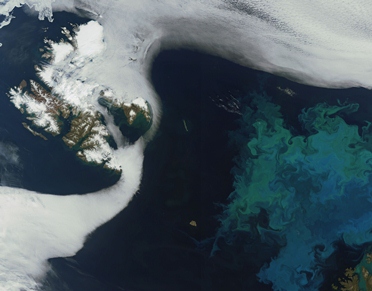 |
October 4, Phytoplankton bloom, visible from space
Last month’s phytoplankton bloom colored the surface of the Barents Sea brilliantly blue and green.
Phytoplankton is responsible for a much of the primary production in the Barents Sea but are often too small to be seen by the naked eye. However in large numbers they can color large expanses of ocean and can even be visible from space.
The milky blue color of this bloom suggests that it is mostly composed of coccolithophores, microscopic plankton plated with white calcium carbonate. The differences in color may be due to differences in depth and concentration, or the presence of sediments or other species of phytoplankton, particularly diatoms. |
October 4, Rabies outbreak on Svalbard
In recent weeks several animals have been confirmed infected by rabies in the immediate vicinity of Longyearbyen.
A fox that attacked woman in Longyearbyen last week, and was subsequently killed by a dog, was infected with rabies Sysselmannen informs. This week two reindeer with paralysis were put down and destroyed after samples had been taken. The woman bitten and four persons who were in immediate contact with the dog as well as 3 others are currently receiving prophylactic treatment. |
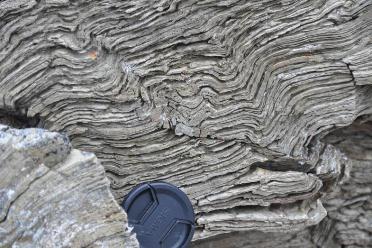 |
October 3, Dip and strike
This summer, thanks to financing from the Arctic Field Grant, PhD student Kim Senger has measured the strike and dip of 2279 fractures in a cliffside near Deltaneset. Find out how and why by reading his field report here
|
October 3, Spineless arctic critters- where do they come from?
This week Mar?a Luisa ?vila Jim?nez defended her PhD thesis on the role and origin of Arctic invertebrates after the last glacial maximum in Svalbard.
The thesis is entitled “High Arctic Invertebrate Biogeography: Patterns and Colonization Processes since the Last Glacial Maximum” and is a corporation between the University Centre in Svalbard (UNIS) and the University of Bergen. |
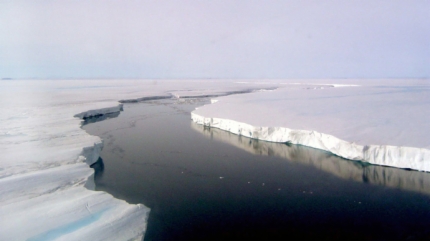 |
September 30, Ice shelves in Arctic disappearing faster than expected
Canadian Arctic ice shelves have lost almost half their volume in the past six years, as part of an astonishing deterioration that an Ottawa researcher says is likely irreversible.
Derek Mueller, an assistant professor in Carleton University's Department of Geography and Environmental Studies, says the ice shelves are going through an unprecedented period of change. "Really on a human timescale, six years is actually a long time," Mueller. |
September 30, IPCC climate models do not capture Arctic sea ice drift acceleration: Consequences in terms of projected sea ice thinning and decline
Key Points:
* IPCC climate models underestimate Arctic sea ice thinning * IPCC climate models fail to capture the recent sea ice kinematics acceleration * Ice export may play a stronger role in the sea ice mass balance in the Arctic |
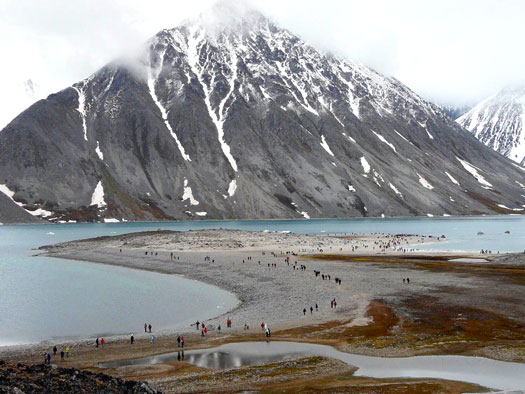 |
September 29, Aliens with latitude
New research shows that humans can unwittingly bring alien plant species to Svalbard. Increased travel activity and expected temperature increases over the next decades, may make the establishment of new plant species in the archipelago’s vulnerable ecosystem possible. This calls for a closer look at the management policy for travelling to Svalbard.
|
September 29, International conference on Arctic shelf opens in Murmansk
The fourth international conference “The Arctic Shelf Exploration: Step-by-Step” is opening in Murmansk in the Russian north on Thursday.
The delegates to the forum include representatives of Gazprom, Statoil Russia, Total Prospecting Development Russia, Shtokman Development AG, The Oil and Gas Institute of the Russian Academy of Sciences as well as other companies and research institutes. |
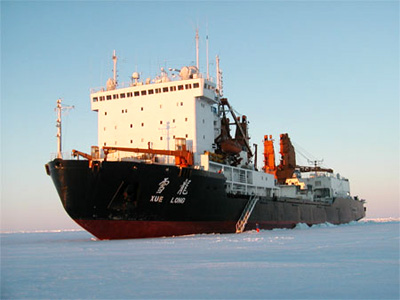 |
September 28, China plans eight expeditions to Arctic and Antarctic in four years
China plans to hold five Antarctic research expeditions and another three to the Arctic region from 2011 to 2015, Xinhua said citing an official with the Chinese Arctic and Antarctic Administration (CAA).
"Chinese researchers will focus on monitoring the weather and environment changes in the polar regions," the agency said, citing CAA head Qu Tanzhou. |
September 28, Musical Weather Shows Climate Influence
Scientists at the Universities of Oxford and Reading have catalogued and analysed depictions of weather in classical music from the 17th Century to the present day to help understand how climate affects how people think.
The researchers were so convinced that classical music is influenced by climate that they pursued this pilot study in their own spare time, outside of their normal scientific work. |
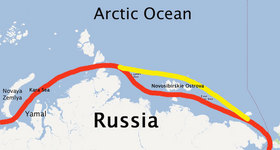 |
September 28, New pathway along Northern Sea Route
Tankers shipping along the Northern Sea Route now choose a new and more northern pathway.
Retreating ice makes it possible for tankers to traffic increasingly further north. According to First Deputy Director of Novatek, Mikhail Popov, the tankers shipping gas condensate along the route are now choosing to sail north of the Novosiberian Island. Until this year, vessels have all sailed south of the island through the Sannikov Strait. |
September 27,Scientists Want Publisher to Refreeze Greenland
The news release promoting the latest edition of Britain’s influential Times Comprehensive Atlas of the World hailed it as “the Greatest Book on Earth.”
Not the way climate scientists see it. “Fiasco” was the word chosen by one scientist in an e-mail to the National Snow and Ice Data Center in Boulder, Colo., alerting his colleagues to erroneous claims made by the publishers of the atlas (whose name derives from The Times of London) about the speed at which Greenland’s glaciers are melting. |
September 27, Major River Basins Have Enough Water to Sustainably Double Food Production in the Coming Decades
While water-related conflicts and shortages abound throughout the rapidly changing societies of Africa, Asia and Latin America, there is clearly sufficient water to sustain food, energy, industrial and environmental needs during the 21st century, according to two special issues of the peer-reviewed journal, Water International, released September 26 at the XIV World Water Congress.
|
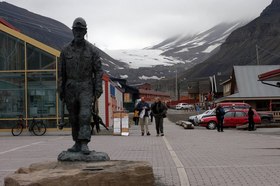 |
September 27, Rabies outbreak on Svalbard
Governor of Svalbard urges the public to avoid contact with dead animals or any animals that are behaving abnormally.
Since 16th September 2011 rabies has been diagnosed in one polar fox and two reindeer, according to the Norwegian Institute of Public Health. |
September 26, China to launch 8 Antarctic, Arctic expeditions
China plans to launch five Antarctic research expeditions and another three to the Arctic from 2011 to 2015, said an official with the Chinese Arctic and Antarctic Administration (CAA) on Sunday.
China will launch the 28th Antarctic research expedition in early November and the fifth to the Arctic in early July 2012, said Qu Tanzhou, director of the CAA, at the annual seminar on China's polar region expedition and research in Shanghai. In the 2011-2015 period, Chinese researchers will focus on monitoring the weather and environment changes in the polar regions, Qu said. |
September 26, Model Provides Successful Seasonal Forecast for the Fate of Arctic Sea Ice
Relatively accurate predictions for the extent of Arctic sea ice in a given summer can be made by assessing conditions the previous autumn, but forecasting conditions more than five years into the future depend on understanding the impact of climate trends on the ice pack, new research shows.
Current conditions form an important starting point that governs how the ice responds to weather in the course of a few years, University of Washington-led research shows. |
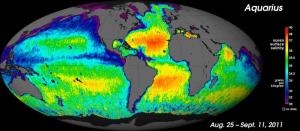 |
September 26, Aquarius Yields NASA's First Global Map of Ocean Salinity
NASA's new Aquarius instrument has produced its first global map of the salinity of the ocean surface, providing an early glimpse of the mission's anticipated discoveries.
Aquarius, which is aboard the Aquarius/SAC-D observatory, is making NASA's first space observations of ocean surface salinity variations -- a key component of Earth's climate. Salinity changes are linked to the cycling of freshwater around the planet and influence ocean circulation. |
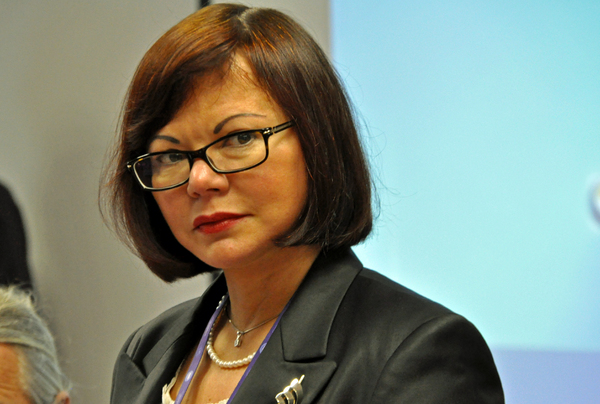 |
September 23, Incubator for new polar researchers
The University of the Arctic’s research Office will be the place to find the next generation’s polar researchers, said Artur Chilingarov at the opening of the office today.
The famous polar researcher and the Russian President’s special aide on Arctic and Antarctic affairs is appointed scientific leader of the University of the Arctic’s (UArctic) first research office, which opened at the Northern Arctic Federal University (NArFU) in Arkhangelsk today. |
September 23, Russia to begin Barents Sea shelf exploration in 2012
Russia will begin geological exploration of the promising Barents Sea shelf located on the border with Norway in 2012, Russia's Natural Resources Minister Yury Trutnev said on Thursday.
After reaching a key deal with Norway over Arctic maritime borders last year, Russia is now embarking on developing large fields located in border zones, Trutnev said in Arkhangelsk at the second international forum The Arctic: Territory of Dialogue. |
September 23, Russian global positioning & navigation system fully covering Arctic
Russia’s global positioning and navigation system GLONASS covers the entire Arctic region, Anatoly Shilov, a deputy director of the Russian federal space agency Roscosmos said Thursday as he took the floor at an international Arctic forum underway here.
“One of the problems has been resolved in full and that’s the problem of satellite navigation, as our GLONASS system has a hundred percent coverage of the entire area,” Shilov said.
The system has a precision of 5.5 meters and what is more, reserves capabilities of the positioning instruments are being created. |
September 22, Research vessel back from 45-day Arctic run
The research vessel Professor Molchanov of Sevgidromet (the Northern hydrometeorological service) returned on Wednesday to Arkhangelsk after the 45-day run to study the Arctic.
The research vessel had reached Vrangel Island on the boundary of the East Siberian Sea and the Chukchi Sea, a source in the hydrometeorological service told Itar-Tass. An international team of paleonthologists led by Frederik Paulsen used to work there. They found more than 500 fragments of remains of mammoths, extinct for several millennia. |
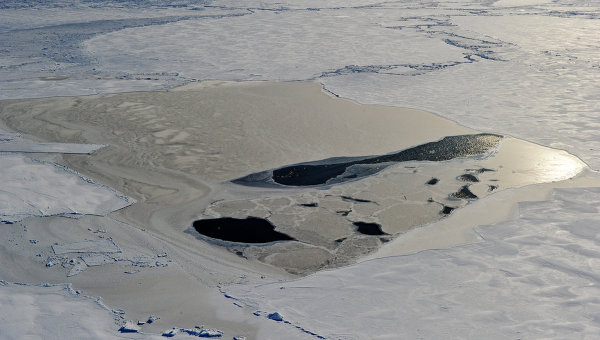 |
September 22, Russia opposes presence of military blocs in Arctic - diplomat
Russia stands against the use of force and the presence of military blocs in the Arctic, a senior Russian diplomat said on Wednesday.
"We do not see problems [in the Arctic] that could lead to the use of force, and we do not see the need to place military-political blocs there," said Anton Vasilyev, ambassador-at-large on Arctic issues at the Russian Foreign Ministry. |
September 21, Antarctic oil sets up cold war
Construction of a startling new base on the Ross Sea coast will bring millions of dollars to Christchurch but raises questions over possible rival bids over New Zealand's potentially oil-rich Antarctic claim.
South Korea, using a Lyttelton-based icebreaker, will next year begin building a $120 million base at Terra Nova Bay, 300km north of New Zealand's Scott Base. Jang Bogo, named after an eighth-century maritime king who controlled Asia's Yellow Sea, will be one of the largest permanent bases after Scott Base and the United States' McMurdo Station. |
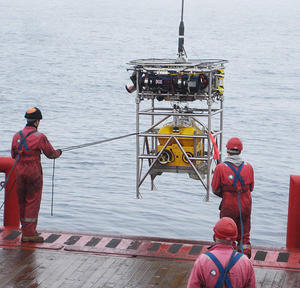 |
September 21, Understanding Methane's Seabed Escape
A shipboard expedition off Norway, to determine how methane escapes from beneath the Arctic seabed, has discovered widespread pockets of the gas and numerous channels that allow it to reach the seafloor.
|
September 20, UNIS strengthens cooperation with Norwegian universities
Today UNIS signed a new cooperation agreement with seven of the Norwegian mainland universities. Tora Aasland, the Minister of Research and Higher Education, was also present. – UNIS plays an important role for the mainland universities and Norway as a whole, said minister Aasland.
|
September 20, Extreme Steps Needed to Meet Climate Target
New research, to be published in the journal Climatic Change in November, suggests humankind may have to remove carbon dioxide (CO2) from the atmosphere on a vast scale if emissions keep rising after 2020.
The series of articles provide scenarios which will form the basis of the next report by the U.N.'s Intergovernmental Panel on Climate Change (IPCC) in 2013 and 2014. |
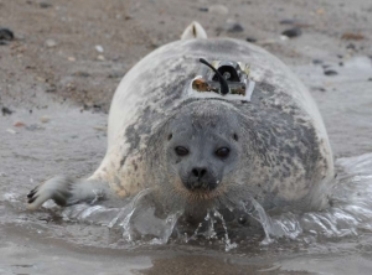 |
September 19, Seals and satellites
In the past month several seals have been fitted with satellite transmitters that will give new insight into their environment and daily life.
Researchers from the Norwegian Polar institute (NPI) have in the past weeks caught and attached transmitters to 11 ringed and five bearded seals in the Kongsfjorden area. The transmitters will hopefully stay attached to the seals until the next moulting period. The data recorded include GPS positions, depth and length of dives made by the seals, temperature and salt content of the water and primary production in the area. |
September 19, Deep Oceans Can Mask Global Warming for Decade-Long Periods
The planet's deep oceans at times may absorb enough heat to flatten the rate of global warming for periods of as long as a decade even in the midst of longer-term warming, according to a new analysis led by the National Center for Atmospheric Research (NCAR).
The study, based on computer simulations of global climate, points to ocean layers deeper than 1,000 feet (300 meters) as the main location of the "missing heat" during periods such as the past decade when global air temperatures showed little trend. The findings also suggest that several more intervals like this can be expected over the next century, even as the trend toward overall warming continues. |
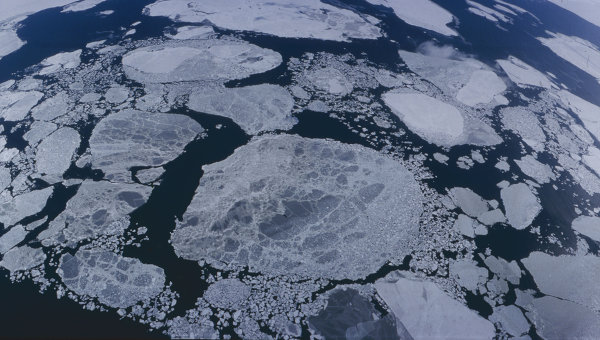 |
September 16,Japanese meteorological firm to launch satellite to track Arctic sea ice
Japanese Weathernews will launch a satellite in September 2012 that will provide navigational services to ships travelling along the Russian and North American coasts in the Arctic Ocean, the newspaper Nikkei reported.
|
September 16,The Arctic: Directions and Mechanisms of International Cooperation
Russian news and information agency RIA Novosti hosted a Moscow-Washington video linkup The Arctic: Directions and Mechanisms of International Cooperation. The event coincided with the 15th anniversary of the establishment of the Arctic Council and the run-up to the second international forum The Arctic: Territory of Dialogue to be held September 22-24.
|
September 16, Study Arctic environmental pollutants and toxicology
UNIS offers three back-to-back master/PhD courses in Arctic environmental pollutants and toxicology in spring 2012. Each course is a 10 ECTS course and you can apply for one or more of these courses. Application deadline is 15 October 2011
|
September 15, Can Scientists Look at Next Year's Climate?
Is it possible to make valid climate predictions that go beyond weeks, months, even a year? UCLA atmospheric scientists report they have now made long-term climate forecasts that are among the best ever -- predicting climate up to 16 months in advance, nearly twice the length of time previously achieved by climate scientists.
|
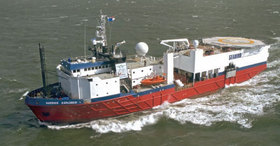 |
September 15, Norway one seismic year ahead of Russia
Norway has just finished the first season of seismic survey in the newly established border area in the Barents Sea. Russia plans to start in 2012.
The vessel “R.V Harrier Explorer” and the company PGS Exploration has just finished this year’s surveying of the Barents Sea floor. A total of 11,400 linear kilometres of two-dimensional seismic data has been collected, Upstream reports. |
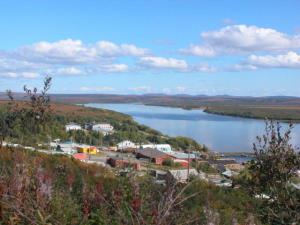 |
September 14, Observations of Climate Change from Indigenous Alaskans
Personal interviews with Alaska Natives in the Yukon River Basin provide unique insights on climate change and its impacts, helping develop adaptation strategies for these local communities.
The USGS coordinated interviews with Yup'ik hunters and elders in the villages of St. Mary's and Pitka's Point, Alaska, to document their observations of climate change. They expressed concerns ranging from safety, such as unpredictable weather patterns and dangerous ice conditions, to changes in plants and animals as well as decreased availability of firewood. |
September 14, Arctic fjords: Challenging for weather prediction models
Arctic fjords represent one of the most challenging environments in the world for weather prediction and climate models. PhD candidate Tiina Kilpelainen has identified the main challenges for the weather prediction models. Kilpelainen will defend her thesis on September 15 at UNIS.
|
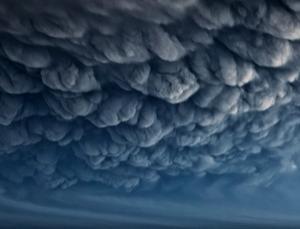 |
September 13, Geoengineering trials get under way
Field trials for experiments to engineer the climate have begun. Next month a team of UK researchers will hoist one end of a 1-kilometre-long hose aloft using a balloon, then attempt to pump water up it and spray it into the atmosphere.
The water will not affect the climate. Rather, the experiment is a proof of principle to show that we can pump large quantities of material to great heights. If it succeeds, a larger-scale version could one day pump sulphate aerosols into the stratosphere, creating a sunshade that will offset the greenhouse effect. |
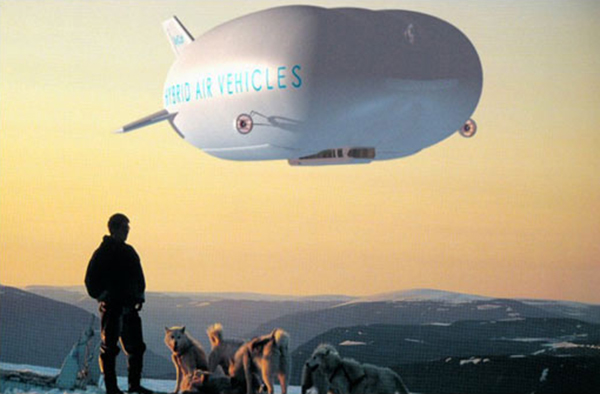 |
September 13, Fleet of hybrid airships to conquer Arctic
Travelling through the Arctic is notoriously difficult and climate change is making it even harder. But there is a way to rise above the problem: the latest generation of lighter-than-air vehicles. Canadian company Discovery Air has signed a contract with the UK's Hybrid Air Vehicles (HAV) to buy around 45 new hybrid air vehicles. These aircraft will be used across Canada's Northwest Territories.
|
September 12,
September, 12 2011.
Extreme Summertime Temperatures to Become a Regular Occurrence, Researcher Predicts
In an article in the current issue of the journal Climate Change Letters, a Boston University researcher has estimated the impact near-term increases in global-mean temperatures will have on summertime temperatures in the U.S. and around the globe.
The "2°C global warming target" is in reference to the current international efforts to reduce emissions of heat-trapping gases and limit human-induced global-mean near-surface temperature increases to 2°C (3.5°F) relative to the pre-industrial era, three-fifths of which has already occurred. |
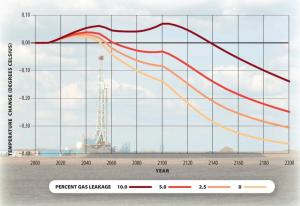 |
September 12, Switching from Coal to Natural Gas Would Do Little for Global Climate, Study Indicates
Although the burning of natural gas emits far less carbon dioxide than coal, a new study concludes that a greater reliance on natural gas would fail to significantly slow down climate change.
The study by Tom Wigley, who is a senior research associate at the National Center for Atmospheric Research (NCAR), underscores the complex and sometimes conflicting ways in which fossil fuel burning affects Earth's climate. |
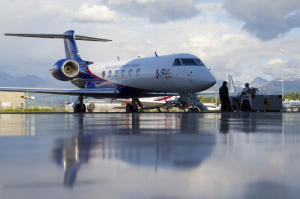 |
September 9, First Global Portrait of Greenhouse Gases Emerges from Pole-To-Pole Flights
A three-year series of research flights from the Arctic to the Antarctic has successfully produced an unprecedented portrait of greenhouse gases and particles in the atmosphere, scientists announced. The far-reaching field project, known as HIPPO, is enabling researchers to generate the first detailed mapping of the global distribution of gases and particles that affect Earth's climate.
|
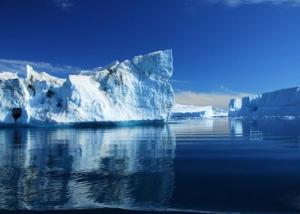 |
September 9,
800,000 Years of Abrupt Climate Variability: Earth's Climate Is Capable of Very Rapid Transitions
An international team of scientists, led by Dr Stephen Barker of Cardiff University, has produced a prediction of what climate records from Greenland might look like over the last 800,000 years.
Drill cores taken from Greenland's vast ice sheets provided the first clue that Earth's climate is capable of very rapid transitions and have led to vigorous scientific investigation into the possible causes of abrupt climate change. |
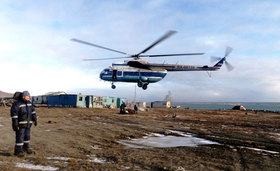 |
September 9, Russian cleanup of Arctic island
Russian authorities have started to remove abandoned oil barrels from the Arctic island of Wrangel. Next in the line is the archipelago of Franz Josef Land, says the Ministry of Natural Resources.
|
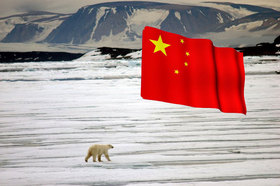 |
September 8, Knockin’ on Arctic’s door
China wants to play a critical role in Arctic research, environmental protection, resource exploration and navigation. Warns against monopolizing Arctic affairs.
|
September 8, New North Pole drifting station to be launched in October – institute
The North Pole 39 drifting station will start its mission in the Arctic Ocean in October to replace North Pole 38, head of the Arctic expedition Vladimir Sokolov from the Arctic and Antarctic Research Institute of the Federal Hydro-Meteorological Service told Itar-Tass on Tuesday.
North Pole 39 personnel and property are being prepared for the mission, he said. Alexander Mikheyev will be the station commander. The average age of the explorers is 40 years. Many of them have been on Arctic missions before. The station will have a vast research program, Sokolov said. |
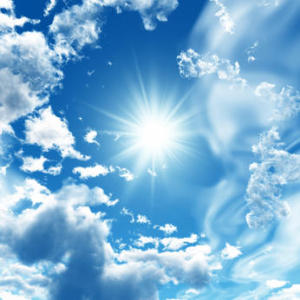 |
September 7, Clouds Don't Cause Climate Change, Study Shows
Clouds only amplify climate change, says a Texas A&M University professor in a study that rebuts recent claims that clouds are actually the root cause of climate change.
|
September 7, Ptarmigans on treadmills
A recently published paper investigating the speed and endurance of Svalbard Ptarmigan found that, on average, males can run both longer and faster than females.
A team at the University of Manchester studied 11 ptarmigans housed at the University of Troms? in order to determine their metabolic rates and running abilities. In the month leading up to the experiment the birds were trained to run in airflow controlled glass boxes on treadmills. |
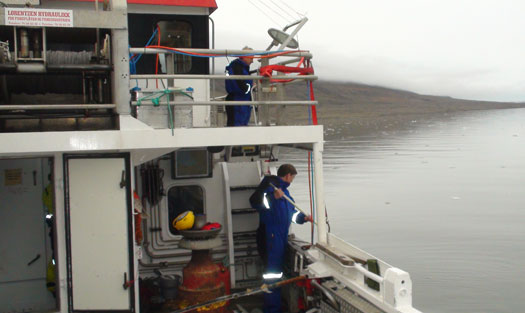 |
September 7, Remote study of sea water and ice
Last week a new method of remote sensing of polar waters and ice was tested in the cold laboratory at UNIS and during field work by using Raman and Rayleigh scattering LIDAR onboard the “Viking Explorer” in Isfjorden and Van Mijenfjorden.
|
September 6, UNIS offers courses at the undergraduate and graduate level in four fields: Arctic Biology (AB), Arctic Geology (AG), Arctic Geophysics (AGF) and Arctic Technology (AT).
Full semester studies are available at the undergraduate level (200-level). At the graduate level (300-level) UNIS offers shorter and more intensive courses spanning from a few weeks up to a semester. Read more about the course levels further down the page.
|
September 6, Total Arctic sea ice at record low in 2010: study
The minimum summertime volume of Arctic sea ice fell to a record low last year, researchers said in a study to be published shortly, suggesting that thinning of the ice had outweighed a recovery in area.
The study estimated that last year broke the previous, 2007 record for the minimum volume of ice, which is calculated from a combination of sea ice area and thickness. |
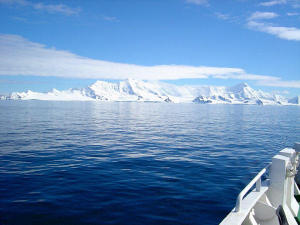 |
September 5, Climate in the Past Million Years Determined Greatly by Dust in the Southern Ocean
A group of scientists led by researchers from the Universitat Aut?noma de Barcelona (UAB) and the Swiss Federal Institute of Technology has quantified dust and iron fluxes deposited in the Antarctic Ocean during the past 4 million years. The research study published in Nature evidences the close relation between the maximum contributions of dust to this ocean and climate changes occurring in the most intense glaciation periods of the Pleistocene period, some 1.25 million years ago. Data confirms the role of iron in the increase in phytoplankton levels during glacial periods, intensifying the function of this ocean as a CO2 sink.
|
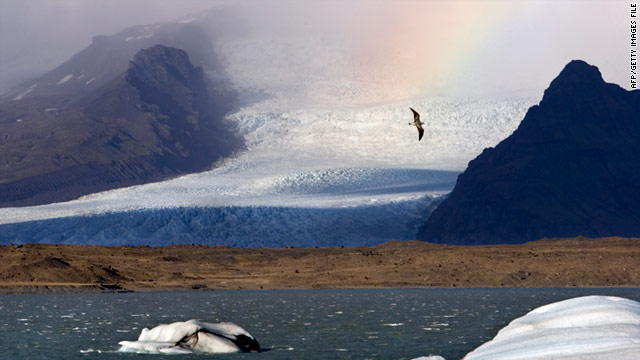 |
September 5, Chinese tycoon seeks to buy tract of Iceland
A Chinese tycoon plans to buy a vast tract of Icelandic land for a $100m tourism project which critics fear could give Beijing a strategic foothold in the North Atlantic.
Huang Nubo, a real estate investor and former Chinese government official, has struck a provisional deal to acquire 300 square kilometres of wilderness in north-east Iceland where he plans to build an eco-tourism resort and golf course. Opponents have questioned why such a large amount of land -- equal to about 0.3 per cent of Iceland's total area -- is needed to build a hotel. They warned that the project could provide cover for China's geopolitical interests in the Atlantic island nation and Nato member. |
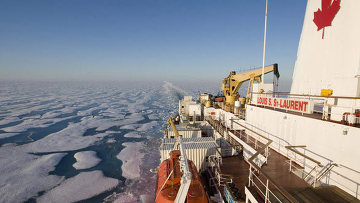 |
September 2, Canadian icebreaker joins the polar parade
It’s getting almost crowded at the North Pole – and a lot easier to get there.
Barely 10 days after the German icebreaker Polarstern reached the North Pole, the elderly Canadian icebreaker Louis St. Laurent and its newer, more powerful American consort, Healy, were only a few kilometres away and expected to reach the top of the world Friday. |
September 2, Computers to pinpoint wild weather forecasts
Computer simulations of the weather workings of the entire planet will be able to make forecasts to within a few kilometers accuracy, helping predict the effects of deadly weather systems.
But the world may have to wait 20 to 40 years' for such accurate information on weather events like El Nino as computer capacity grows, a senior British scientist said Thursday. |
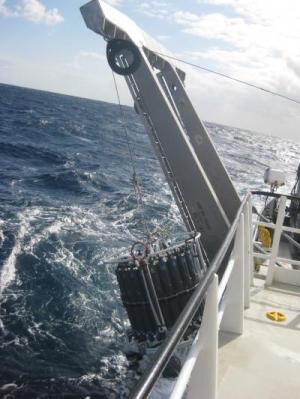 |
September 1, Decade-Long Study Reveals Recurring Patterns of Viruses in the Open Ocean
Viruses fill the ocean and have a significant effect on ocean biology, specifically marine microbiology, according to a professor of biology at UC Santa Barbara and his collaborators.
Craig A. Carlson, professor with UCSB's Department of Ecology, Evolution, and Marine Biology, is the senior author of a study of marine viruses published this week by the International Society for Microbial Ecology Journal, of the Nature Publishing Group. |
September 1, Monitoring Ground-Level Ozone from Space
Satellite views of the Midwestern United States show that ozone levels above 50 parts per billion (ppb) along the ground could reduce soybean yields by at least 10 percent, costing more than $1 billion in lost crop production, according to U.S. Department of Agriculture (USDA) scientists.
|